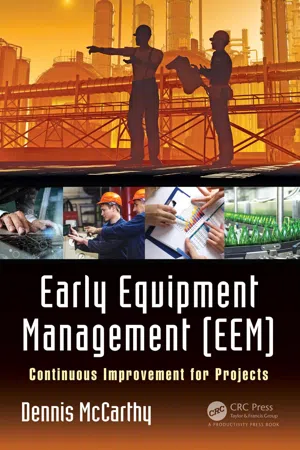
Early Equipment Management (EEM)
Continuous Improvement for Projects
Dennis McCarthy
- 284 pages
- English
- ePUB (mobile friendly)
- Available on iOS & Android
Early Equipment Management (EEM)
Continuous Improvement for Projects
Dennis McCarthy
About This Book
When capital projects fail to deliver, it is usually not due to technical reasons but a combination of behavioral pitfalls, unclear accountabilities and gaps in design, specification, and/or project-management processes.
Early Equipment Management (EEM): Continuous Improvement for Projects explains how well known and award winning organizations avoid these weaknesses by using:
-
- Project road maps setting out clear accountabilities for each step of the concept-to-project-delivery process;
-
- Progressive design goals for each step to assure the delivery of low life-cycle costs;
-
- Processes to codify tacit knowledge, reveal latent design weaknesses, and build high performance cross-functional team collaboration;
-
- Project governance processes that systematically raise their organizations ability to reduce time to market for new assets, products and services with higher added value and fewer resources. Hence the books title of continuous improvement for projects.
The word Early in EEM refers to the principle of trapping problems as early as possible in the project process when they are cheapest to resolve. That makes EEM relevant to all projects even those that have past the design stages. To support the use of EEM at any project step, the author has designed each chapter as a standalone topic with cross references to other chapters where relevant. This book: -
-
- Explains
- The six EEM project delivery steps setting out the tasks and accountabilities for project teams, project managers and steering committees at each step;
- How to organize projects to increase project added value through the collaboration of commercial, operational and technology stakeholders
- The wiring up behind behaviors that contribute to the failure of traditional project management approaches and how to avoid those pitfalls;
- The use of projects as a vehicle for the development of internal talent and increase capital project added value
- The systematic development of internal capabilities to deliver flawless operation from day one in less time with less resources
- How raising project governance capability directly impacts on company wide management competence
-
- Uses case studies to explain how to implement the EEM methodology and
-
- Describes how EEM principles and techniques applied to product and service development (Early Product Management) multiplies the gains from EEM.
This book shows readers how and why EEM works so that they can design their own EEM road map and continuous improvement process for projects.
Frequently asked questions
Information
Delivering Capital Projects
Faster, Cheaper, Better
- Conflicting views of what is needed
- Difficulties in releasing resources
- Lost opportunities to challenge and optimize design choices
- Critical decisions delayed or not taken
- Communication between project stakeholders interrupted or lost
| Title | Content | |
| 1 | Concept | Development of the project idea |
| 2 | High-level design | Approval of funding |
| 3 | Detailed design | Selection of vendors and detailed planning |
| 4 | Prefabrication procurement | Preparation of site and manufacture/procurement of equipment |
| 5 | Installation | Position and connect equipment |
| 6 | Commissioning | Set up and run equipment and validate process capability |

Traditional capital project delivery.
Table of contents
- Cover
- Half-Title
- Title
- Copyright
- Contents
- Preface
- 1 Early Equipment Management: Delivering Capital Projects Faster, Cheaper, Better
- 2 The EEM Road Map
- 3 Design and Performance Management
- 4 Specification and LCC Management
- 5 Project and Risk Management
- 6 Project Governance
- 7 Implementing EEM
- 8 Early Product Management
- chapter9
- Notes
- Index